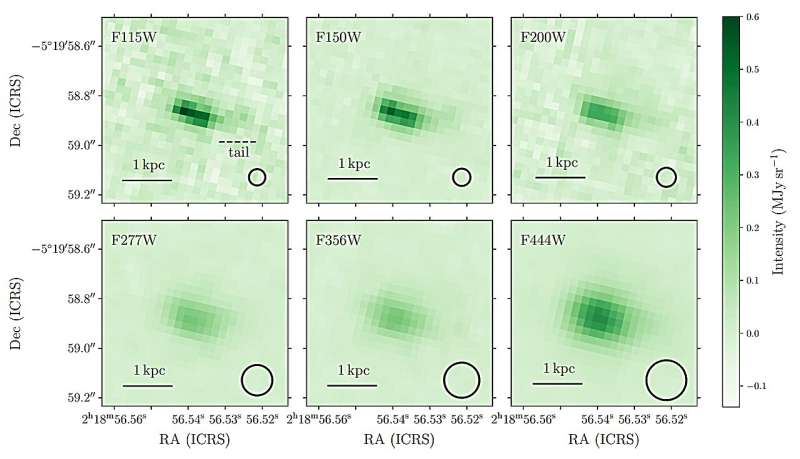
An international team of astronomers has made significant observations of a distant galaxy known as SXDF-NB1006-2, utilizing the advanced capabilities of the James Webb Space Telescope (JWST). Their findings, detailed in a paper published on October 29, 2025, reveal that this galaxy is a young starburst galaxy characterized by ionized gas outflows, located approximately 12.9 billion light years from Earth.
Discovered in 2011, SXDF-NB1006-2 has intrigued scientists due to its potential as one of the most distant known galaxies. Earlier observations hinted at a rapid star formation timeline of about 1 to 2 million years. Now, led by Yi W. Ren from Waseda University in Tokyo, the research team has employed JWST’s Near Infrared Camera (NIRCam) and Near Infrared Spectrograph (NIRSpec) to delve deeper into the galaxy’s characteristics.
Key Findings from Observations
The observations indicated that the ultraviolet continuum of SXDF-NB1006-2 displays an elongated, clumpy morphology with a tail-like structure. This suggests the presence of an edge-on disk or a chain galaxy. Additionally, the detected oxygen emission also exhibited clumpy features, with a tail extending westward, implying that SXDF-NB1006-2 may have undergone galaxy merger events in its history.
A significant discovery was the identification of a broad component of the oxygen emission line spanning approximately 6,000 light years. This broad feature indicates the presence of prominent ionized gas outflows, further confirming the galaxy’s active star formation. The research indicates that SXDF-NB1006-2 is dominated by young stellar populations and is currently experiencing an intense burst of star formation.
The study estimates that the galaxy has a star formation rate of around 38 solar masses per year and a metallicity level of 0.2 solar metallicities. The total gas mass of SXDF-NB1006-2 is approximately 19.3 billion solar masses, with a gas depletion time estimated at about 144 million years.
Implications for Galaxy Formation Theories
The authors of the study conclude that SXDF-NB1006-2 could become quenched at a redshift of around 6.5 or 5.0. This suggests that the galaxy might serve as a progenitor for the massive quiescent galaxies observed at redshifts of approximately 4.0 to 5.0.
The derived gas depletion time of several hundred million years implies that SXDF-NB1006-2 may be a precursor to these massive galaxies identified in recent JWST observations. As stated in the paper, “the target could be one of the progenitors of massive quiescent galaxies at z ∼ 4−5.”
These findings contribute to our understanding of galaxy formation and evolution in the early universe, shedding light on the processes that govern star formation and the lifecycle of galaxies. As astronomers continue to explore the cosmos with advanced tools like the JWST, discoveries like that of SXDF-NB1006-2 underscore the dynamic nature of our universe.







